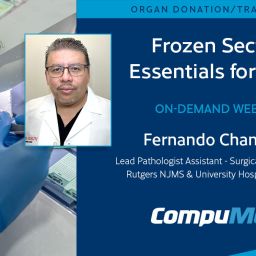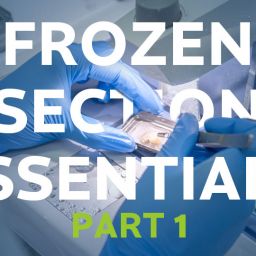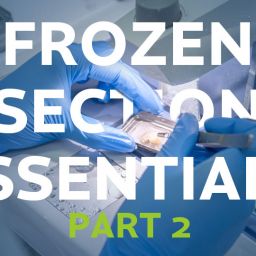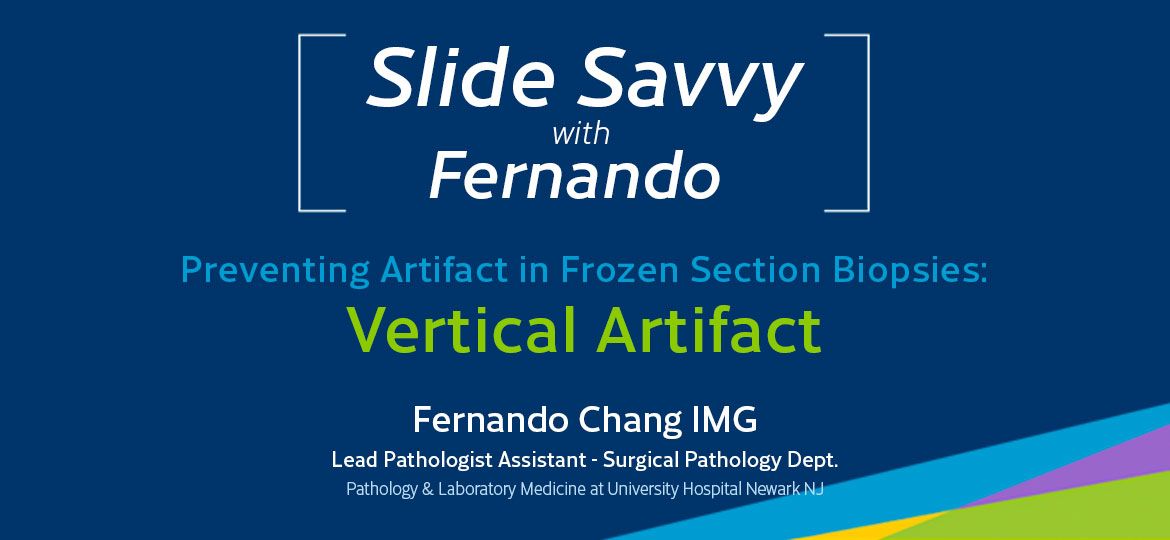
The following blog features excerpts from our expert webinar series, Slide Savvy with Fernando. Fernando Chang, IMG, a pathologist assistant renowned for his expertise in frozen section analysis, addresses some common issues with frozen section slide preparation and introduces tips for freezing, handling and sectioning that will empower you to create high quality slides that help save lives.
You can think of artifact—distortions or anomalies in frozen tissue samples—like a smudge on a camera lens. No matter how sharp the image was supposed to be, the smudge makes it nearly impossible to see clearly.
For donor organ frozen section slides, the presence of artifact can have serious consequences, such as delayed interpretations or, in some cases, the organ being discarded unnecessarily. At CompuMed, we aim to provide OPOs with tips for identifying and preventing types of artifact before they become a problem.
This blog explains how to spot one common issue—vertical artifact—and ensure it doesn’t interfere with your mission to save lives through organ donation and transplantation.
What is Vertical Artifact?
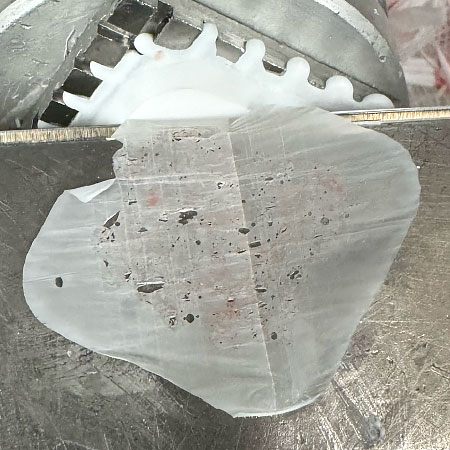
Vertical artifact occurs when the sectioning blade doesn’t cut smoothly through a donor organ frozen tissue sample. It results in uneven slicing that looks just as its name suggests, like a vertical pattern that may include streaks, grooves or jagged lines running perpendicular to the tissue.
Pathologists typically classify vertical artifact into two types: thin strikes and wide strikes. These variations have different causes. Understanding their origins can empower you to troubleshoot the artifact and create higher-quality frozen section slides that enable faster and more accurate organ evaluations.
What causes thin strikes?
When vertical artifact appears as thin strikes, it often indicates an issue with tissue hardness.
Small pinpoint calcifications or granulation tissue—a type of new connective tissue that forms during a wound’s healing process—may be present within the sample and disrupt the movement of the blade.
Thin strikes could also result from the presence of foreign materials, such as the remaining fragments of staples or sutures. If removed carefully, high-quality frozen section slides can still be created without further complications.
What causes Wide strikes?
When vertical artifact appears as wide strikes, it’s a sign to check for fatty tissue, which is particularly common in kidney biopsy samples.
“We need to clean fat off the sample,” says CompuMed’s lead pathologist assistant, Fernando Chang, IMG. “Otherwise, we’ll see wide strike vertical artifact.”
You should also ensure you’ve reached the ideal temperature of the cryostat and tissue sample for frozen sectioning.
“Best practice is to set the cryostat at -23 or -25 degrees Celsius, but fatty tissue freezes at a significantly lower temperature, approximately -80 degrees Celsius,” says Fernando.
If you attempt to cut a section from fatty tissue, you may notice what Fernando calls the “butter effect.”
“The softness of under-frozen tissue causes it to behave like butter under the blade,” he says. “Instead of cutting cleanly, the tissue resists and rolls, and you’ll see those wide strikes.”
Additional Issues Causing Artifact
Additional causes of artifact can include tissue debris or OCT media beneath the blade, as well as a technical issue with the cryostat setup.
- Tissue debris. This is not necessarily fat but can be general debris that accumulates under a blade with use. A simple solution is to change the blade frequently and perform routine checks for debris. “I always start with a new blade,” says Fernando.
- OCT media. If the OCT (Optimal Cutting Temperature) compound has not fully solidified before sectioning, it can build up beneath the blade and cause the tissue to shift during cutting. “Sometimes we start cutting too soon,” says Fernando. “At the time of sectioning, the media should be a solid white color. If it is gray, it hasn’t reached the ideal cutting temperature.”
- Stage-related issues. The cryostat stage has both moving and fixed components. Proper adjustment of the tissue block on the block holder is critical because if it isn’t secured tightly, the block can loosen while you are cutting. This can cause the steel surface of the chuck to collide with the cryostat stage, leading to a loud, unpleasant sound and potentially damaging the stage. Stage-related issues often lead to ruined slides and the need to repair or replace the cryostat stage.
Proper training is key
Above all, Fernando emphasizes that proper training and practice are essential for identifying all types of frozen section artifact, including vertical artifact, and quickly addressing problems that compromise slide quality.
“You’re only going to gain the muscle memory by doing it,” says Fernando. “You’ll get to know your machines and learn how to cut sections and how to recognize problems immediately. For example, with proper training, vertical artifact becomes easier to spot.”
“Then you’re going to solve the problem and have a better section for the pathologist,” he adds. “Ultimately, this helps save lives, which is what it’s all about.”

Fernando Chang IMG
Lead Pathologist Assistant – Surgical Pathology Department
Pathology and Laboratory Medicine at University Hospital Newark NJ
Rutgers Medical School
Summit Health
Atlantic Health Care System
RWJ Barnabas Healthcare system
Drawing from methodologies pioneered by the late Dr. Stephen Peters, Fernando collaborates with the Rutgers NJMS Pathology Residency program main surgical pathology and autopsy rotation at University Hospital. Here, he imparts innovative techniques in Anatomic Pathology Rotation, Frozen Sections, and the utilization of Telepathology Aperio Scan Scope. With more than 17 years of experience, Fernando has a wealth of expertise in working closely with OPOs.
More Frozen Section Resources
Did you find this helpful? For more tips on minimizing and preventing types of artifact, check out on-demand episodes of our webinar series, Slide Savvy with Fernando.
Interested in consultations and feedback? CompuMed’s lead pathologist assistant is available to provide clients with consultations, training and feedback on samples. Contact us to learn more.
Ready to request a read? Our expert subspecialist network provides some of the most comprehensive, donor-focused biopsy reports in the industry. Take a closer look at what’s included in our reports and how they give transplant centers the confidence to say yes to an organ faster.


